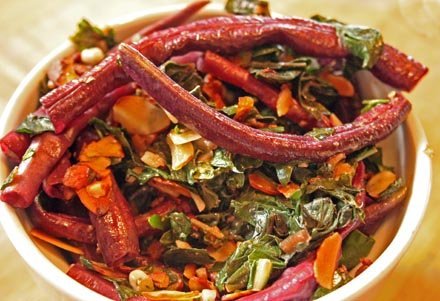
(Vegetarian, vegan, gluten-free)
What is it about food?
I have bronchitis. For a week now, my lungs have been incapable of collecting enough oxygen for comfort. Going up a flight of steps makes me feel like I’ve got somebody’s rusty old fender lodged in my rib cage. I spend more of the wee hours awake and tossing than I do sleeping. I’ve been counting goats to no avail. And so, when the sun rises and I’m supposed to be awake, I don’t much feel like it.
I don’t feel like doing anything. Not gardening. Not talking. Funny movies are dangerous, since inevitably laughter catapults me into a spiraling and painful cough. Certainly I’ll do nothing as brain-intensive as reading a book. I not thinking in complete sentences. I don’t, dear reader, feel like writing either (which is why, you’ll see, I’m letting my photos do much of the talking today).
But the kitchen draws me.
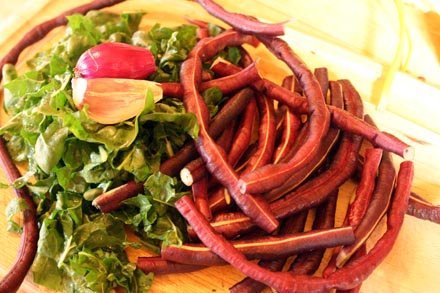
Though my sense of taste is intact, the energy required to metabolize food has rendered eating unappealing. But I don’t stay out of the kitchen. Aimlessly, almost, I keep wandering in. Over the last week I made warm vegetable broth, as much out an ache for something to do as it was out of necessity. I’ve made beet risotto, lovely chloro-full and antioxidant rich, algae-green salads, and a harissa paste meant to sear any germs out of my system.
But why? Why, when I can muster the determination to do little else, do I linger in my kitchen?
It’s something to do with the reassuring feel of things in my hands, I think. When I feel as if my body is somewhere far from the rest of me, and the air I need to breathe is just out of reach, it’s very grounding to feel the floor beneath my feet and a firm, heavy tomato cradled in my palms. Or to trace a finger over the gentle fuzz of a Red Haven peach, to catch its honeyed scent. Or to be jolted by the sharp aroma of fresh rosemary, the sting of it somehow instantly healing. My kitchen marks my place in the world.
It’s trite to make a statement like, “it’s the simple things that matter.” But I can’t deny that being ill (and I use that word tentatively, because in the scope of things this temporary setback is nearly meaningless, and I am fortunate) simplifies things. When there is no energy left, only the things that matter can remain. Apparently, for me, cooking matters.
And it’s the simple foods that matter now, those living things that house the power to restore me to my normal, healthy state. The basic building blocks of my kitchen are also the barest components of my bones and tissues.
On Eating
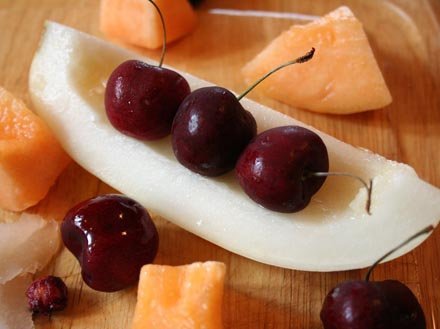
Inevitably, when my mother learns that I have a cold or a flu, she will ask me if I’m taking my vitamin C. I’m not, Mom.
There’s no need. Instead, I’ve been reveling in the things I’ve collected from the local markets. Did you know that one serving of Persian muskmelon contains 112.5% of my daily Vitamin C needs? Or that blackberries, with their inky purple stain, rank way up there for stress-fighting antioxidants? And the peaches! Plentiful at the local market right now, full of nectar-sweet juice and held in by firm, blushing skins, there’s not a mushy, mealy, grainy Red Haven among them. A mouthful of their bright flesh makes me feel vibrant and alive. Then there are cherries. Crimson and intense, they shore me up with a dose of the magic C, as well as potassium, iron and fiber.
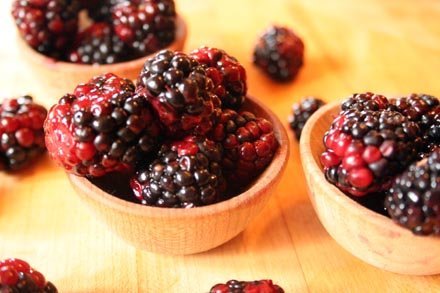
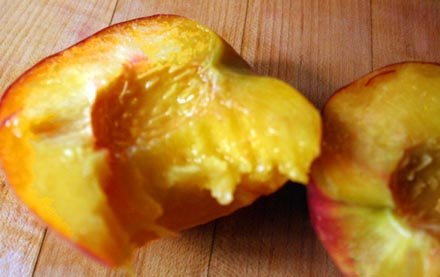
Just looking at all these fresh things makes my breathing come easier. And how does one account for the impact of joy?
A Recipe
Purple is the powerhouse of the vegetable world, nutritionally speaking. Purple produce contains 50% more antioxidants than their non-purple counterparts. Perhaps it’s no surprise then that I naturally gravitated to the Chinese Red Beans dangling in my garden. The natural wisdom of the body doesn’t falter.
I grew these beans the first time last year, from seeds gotten at Baker Creek Heirloom Seeds, and they were truly yard-long. This year they came in a bit shorter, but I think that’s because my garden is a riot of beans elbowing one another for space this summer. Like last year they appeared nearly overnight, one day barely there, the next, their bright pods shocking me from my kitchen window.
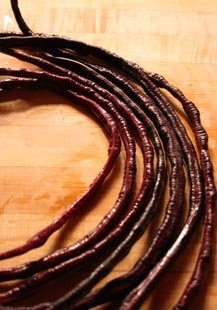
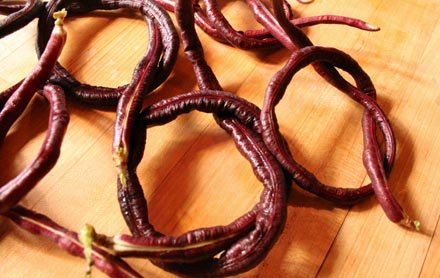
I made a thrilling discovery with them: if I steam them, they keep their purple shade. Do they retain more nutrients post-cooking, then? I don’t know but I’m willing to bet so.
With this dish I was aiming for an antioxidant one-two. I wanted to be kick-boxed into health, so I went on a purple scavenger hunt. The onion is a Spanish heirloom called Tropea, and it bears a small, mild, reddish-mauve elongated bulb. The garlic is Inchelium red, which I got from Seed Saver’s Exchange last year. Here’s a PSA: reserve your Inchelium red now for next year — but not before I’ve had a chance to order some. This spicy, blushing soft-neck variety, one of my all-time favorites, is sold out for this year already. Guess I’ll have to sacrifice a bulb or two to the garden to ensure that another generation here.
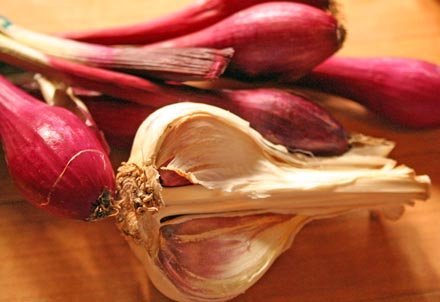
For contrast, I threw in some chard. I’ve been getting a lot of mileage out of a Giant Fordhook Swiss chard plant – these seeds, too, came from SSE. The plant is sturdy, heat tolerant, and continues to sprout new leaves. And for herbs, I choose parsley (for the vitamin K) and marjoram.
Chinese Red Beans with Chard: a Palliative on a Plate
1/2 pound Chinese Red Beans (or other fresh beans)
2 tablespoons raw sliced almonds
1 clove garlic
3 tablespoons chopped red onion, about 2 spring bulbs worth
2 tablespoons finely chopped fresh parsley leaves
1 tablespoon fresh marjoram, sliced
1 cup chard or spinach, chopped
4 teaspoons olive oil
1 teaspoon red wine vinegar
1 teaspoon Dijon mustard
Salt and pepper
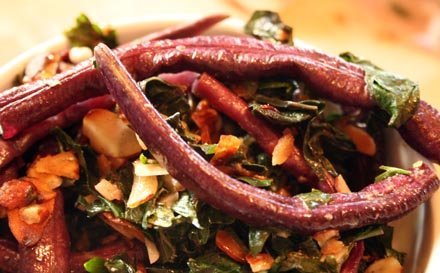
In a dry skillet, toast the almonds over medium heat until they are brown and fragrant, about 3 minutes. Shake pan occasionally to prevent burning.
Remove almonds from skillet. Add 2 teaspoons of the olive oil. On medium heat, sauté the onion and garlic until transluscent, about five minutes. Add the chopped parsley and marjoram and stir for about 1 minute, until heated through. Remove from heat.
In a bowl, combine 2 teaspoons olive oil, the red wine vinegar and the Dijon. Stir in the garlic, onion, parsley and marjoram. Whisk well, then set aside.
Bring a large pot of water with a steamer basket to a boil, add green beans and steam for about 3 minutes. Add chard or spinach and steam 1-2 minutes more (spinach needs less time than chard).
Transfer beans and chard to a bowl. Stir the vinegar-mustard mixture over the beans, then sprinkle with the toasted almonds. Add salt and pepper to taste.
Feel better yet? I do!

Best wishes for a speedy recovery, Becky.
I have the Chinese Noodle Beans this year too, for the first time. They are spectacular, and one is practically a whole meal by itself. Well maybe two. They’re unbelievable though, and my neighbors are awed. I’m enjoying your writing. Feel better soon.
I do hope that you feel better by now.
I just found your blog. You have a beautiful way with words. Thank you.
Hi Jennifer,
I do feel better, thanks. In fact, for a moment when I read your comment I couldn’t remember why I hadn’t felt good. : ) Thank you also for your kind words about my words — that makes me almost happier than being complimented on my cooking. I’m glad you found the site.